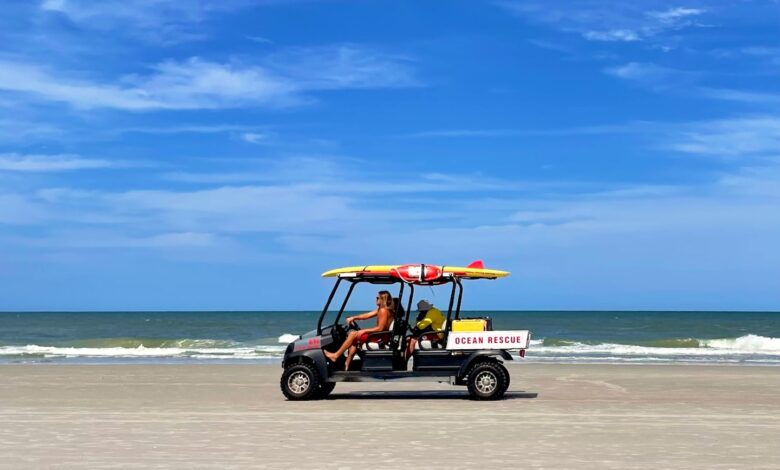There’s real danger in digging deep holes on a sandy beach

[ad_1]
As a coastal science researcher who’s been studying beaches for many years, I was called in to help investigate the girl’s death. Many people tried to help free her, but the sand hole continued to collapse as they dug, and more sand poured in. Firefighters didn’t arrive until several minutes after the incident — too late to resuscitate the victim.
Digging holes in sand might seem innocent, but if the hole is deep enough and collapses on a person, it is extremely difficult to escape. In fact, some research suggests more people die of sand burial suffocation than shark attacks.
Collapsing sand holes led to 31 deaths, mostly children and 87 percent male, from 1997 to 2007 in the United States. During that period, 21 others were in a reported sand hole collapse but survived, many requiring CPR.
Victims of sand hole collapse have ranged in age from 3 to 21. The holes were generally two to 15 feet in diameter and two to 12 feet deep. Digging, tunneling, jumping and falling into the hole have all inadvertently triggered collapse.
Sand isn’t actually a type of material. It’s a category of material size, ranging from 0.0025 to 0.08 inches in diameter. The type of sand is determined by the materials making it up. Quartz sand, made up of silicon dioxide, is the most common sand found on beaches, except for tropical coasts where coral sand beaches, made up of calcium carbonate, are found.
Material coarser than sand is not soft to the touch, and it doesn’t make sturdy sandcastles. Silt and clay, which are finer than sand, make water murky and are commonly called mud.
Sand’s weight depends on the materials it’s made of. Pure quartz sand, which is very white, weighs around 90 pounds per cubic foot when dry.
But most beaches contain a mixture of minerals, creating a tan or brown appearance. The minerals that darken the sand are much heavier — the sand on most beaches would weigh up to 130 pounds per cubic foot when dry.
Dry, loose grains of sand will form a pile with a slope angle of about 33 degrees, termed its angle of repose. The angle of repose is the steepest angle at which a pile of grains remains stable, and the force of friction between each grain determines that stability.
When sand is wet, it’s more stable because the surface tension between water and sand grains can hold the pile of sand in place vertically. But, once it dries, the pile will collapse as there’s no more surface tension.
So, if you dig a hole in the beach, it’ll stay stable for as long as the sand stays moist. Once it dries, the hole collapses.
When the sand forming the hole either dries out or someone stands near the edge of the hole adding extra weight, the sand hole collapses in, and the heavy grains fill all open spaces in the hole. This leaves no air available for a trapped person to breathe.
While skiers trapped in avalanches can cup their hands to form an air pocket because snow is light, that’s not the case when sand collapses.
Rescuing someone from a collapsed sand hole is very difficult because sand is both heavy and unstable. As rescuers scoop away sand to free the victim, the hole will continue to collapse under the rescuers’ weight and re-fill with sand. According to some research, rescuers have only about three to five minutes to save a person who is trapped in a sand hole before they suffocate.
Professionals such as firefighters will place boards across the hole when rescuing someone from a sand hole collapse. This way, they can reach down and use tools to remove the sand without putting any weight directly on the edge of the hole.
Experts recommend never digging a hole deeper than the knee height of the shortest person in your group — with two feet being the maximum depth.
To rescue someone in a collapsing sand hole, focus on exposing their mouth and removing sand from on top of their chest. If you expose their mouth, you can administer rescue breathing while other rescuers continue digging out their chest.
Too many people crowding a sand hole rescue can cause more harm than good. Just two or three rescuers should work in the victim’s immediate area while others work on clearing sand away from the wider excavation area, which makes it easier for those in the center to remove sand. The people on the perimeter can clear sand away from the central area using anything available, from buckets and shovels to beach chairs and boogie boards.
Sand hole collapses can happen suddenly and in situations that don’t seem dangerous to most. Even a shallow hole can injure someone who stumbles into it. So during your next trip to the beach, make sure to keep an eye out for sand holes and fill them as soon as possible.
Stephen P. Leatherman is a professor of coastal science at Florida International University.
This article was produced in collaboration with theconversation.com.
[ad_2]
Source link




